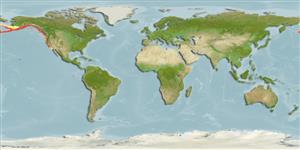Environment: milieu / climate zone / depth range / distribution range
Écologie
marin démersal; profondeur 10 - 1370 m (Ref. 50610). Temperate; 65°N - 31°N, 178°E - 117°W
Eastern Pacific: Navarin Canyon in the Bering Sea to Stalemate Bank in the Aleutian Islands and San Cristobal Bay, Baja California, Mexico.
Length at first maturity / Taille / Poids / Âge
Maturity: Lm 38.5, range 38 - 40 cm
Max length : 76.0 cm TL mâle / non sexé; (Ref. 2850); common length : 40.0 cm TL mâle / non sexé; (Ref. 56527); poids max. publié: 3.5 kg (Ref. 56527); âge max. reporté: 56 années (Ref. 74500)
Épines dorsales (Total): 0; Rayons mous dorsaux (Total): 90-116; Épines anales 0; Rayons mous anaux: 80 - 96; Vertèbres: 50 - 54. Dorsal origin above middle of upper eye. Caudal imperfectly rounded.
Adults occur on mud bottom (Ref. 2850). They move into deep water in winter (Ref. 2850). Produce large amounts of slime which may cover other fishes when caught in trawls (Ref. 4925). Marketed as mink food (Ref. 4925) or as fillet (Ref. 2850).
Vinnikov, K.A., R.C. Thomson and T.A. Munroe, 2018. Revised classification of the righteye flounders (Teleostei: Pleuronectidae) based on multilocus phylogeny with complete taxon sampling. Molecular phylogenetics and evolution, 125:147-162. (Ref. 122998)
Statut dans la liste rouge de l'IUCN (Ref. 130435)
Menace pour l'homme
Harmless
Utilisations par l'homme
Pêcheries: commercial; pêche sportive: oui
Outils
Articles particuliers
Télécharger en XML
Sources Internet
Estimates based on models
Preferred temperature (Ref.
123201): 1.1 - 6.3, mean 3.5 °C (based on 248 cells).
Phylogenetic diversity index (Ref.
82804): PD
50 = 0.5625 [Uniqueness, from 0.5 = low to 2.0 = high].
Bayesian length-weight: a=0.00646 (0.00367 - 0.01135), b=3.07 (2.91 - 3.23), in cm total length, based on LWR estimates for this species & (Sub)family-body (Ref.
93245).
Niveau trophique (Ref.
69278): 3.2 ±0.1 se; based on diet studies.
Résilience (Ref.
120179): Faible, temps minimum de doublement de population : 4,5 à 14 années (tm=5; tmax=56; K=0.26; Fec=37,000).
Prior r = 0.35, 95% CL = 0.23 - 0.52, Based on 3 stock assessments.
Fishing Vulnerability (Ref.
59153): High to very high vulnerability (71 of 100).
Climate Vulnerability (Ref.
125649): Moderate vulnerability (43 of 100).
Nutrients (Ref.
124155): Calcium = 14.7 [8.7, 29.4] mg/100g; Iron = 0.211 [0.121, 0.389] mg/100g; Protein = 16.7 [14.7, 18.8] %; Omega3 = 0.337 [0.163, 0.715] g/100g; Selenium = 27.8 [13.8, 59.9] μg/100g; VitaminA = 7.77 [1.73, 33.10] μg/100g; Zinc = 0.373 [0.269, 0.554] mg/100g (wet weight); based on
nutrient studies.
